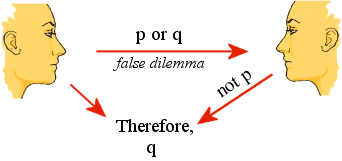|
Also Known as: Black & White Thinking.
A False Dilemma is a fallacy in which a person uses the following pattern of "reasoning":
This line of "reasoning" is fallacious because if both claims could be false, then it cannot be inferred that one is true because the other is false. That this is the case is made clear by the following example:
In cases in which the two options are, in fact, the only two options, this line of reasoning is not fallacious. For example:
Examples:
- Senator Jill: "We'll have to cut education funding this year."
Senator Bill: "Why?"
Senator Jill: "Well, either we cut the social programs or we live with a huge deficit and we can't live with the deficit."
- Bill: "Jill and I both support having prayer in public schools."
Jill: "Hey, I never said that!"
Bill: "You're not an atheist are you Jill?"
- "Look, you are going to have to make up your mind. Either you decide that you can afford this stereo, or you decide you are going to do without music for a while."
A limited number of options (usually two) is given, while in reality there are more options. A false dilemma is an illegitimate use of the "or" operator.
Putting issues or opinions into "black or white" terms is a common instance of this fallacy.
More Examples:
- Either you're for me or against me.
- America: love it or leave it.
- Either support George Bush or be considered a terrorist.
- Every person is either wholly good or wholly evil.
Proof:
Identify the options given and show (with an example) that there is an additional option.
<< Return
|

